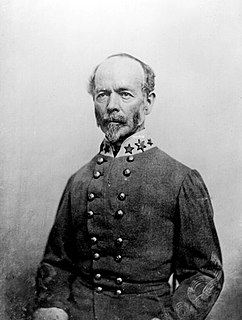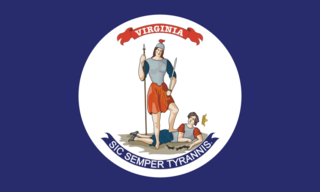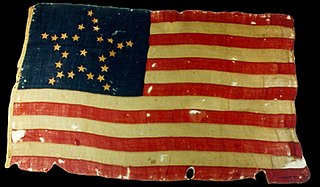Related Research Articles

The Second Battle of Winchester was fought between June 13 and June 15, 1863 in Frederick County and Winchester, Virginia as part of the Gettysburg Campaign during the American Civil War. As Confederate Lieutenant General Richard S. Ewell moved north through the Shenandoah Valley in the direction of Pennsylvania, his corps defeated the Union Army garrison commanded by Major General Robert H. Milroy, capturing Winchester and numerous Union prisoners.
The Stonewall Brigade of the Confederate Army during the American Civil War, was a famous combat unit in United States military history. It was trained and first led by General Thomas J. "Stonewall" Jackson, a professor from Virginia Military Institute (VMI). His severe training program and ascetic standards of military discipline turned enthusiastic but raw recruits into an effective military organization, which distinguished itself from the First Battle of Bull Run in 1861 to Spotsylvania Court House in 1864. Its legacy lives on in the 116th Infantry Brigade, which bears the unofficial nickname "Stonewall Brigade," and in several living history reenactment groups.

The Army of the Shenandoah was an army of the Confederate States of America during the American Civil War; it was organized to defend the Shenandoah Valley of Virginia in the early months of the war. The army was transferred to reinforce the Confederate Army of the Potomac at the First Battle of Bull Run, which was its only major action. After the battle, the army was merged into the Army of the Potomac.

The 33rd Virginia Infantry Regiment was an infantry regiment raised in the Commonwealth of Virginia for service in the Confederate States Army during the American Civil War. It was a part of the famed "Stonewall Brigade," named for General Stonewall Jackson.

The city of Winchester, Virginia, and the surrounding area, were the site of numerous battles during the American Civil War, as contending armies strove to control the lower Shenandoah Valley. Winchester changed hands more often than any other Confederate city.
The 122nd Ohio Infantry Regiment, sometimes 122nd Ohio Volunteer Infantry was an infantry regiment in the Union Army during the American Civil War.
The 87th Pennsylvania Volunteer Infantry was an infantry regiment that served in the Union Army during the American Civil War.

The 27th Virginia Infantry Regiment was an infantry regiment raised in Virginia for service in the Confederate States Army during the American Civil War. It fought mostly with the Stonewall Brigade of the Army of Northern Virginia.

The 2nd Virginia Infantry Regiment was an infantry regiment raised in today's western Virginia and what became West Virginia during the American Civil War for service in the Confederate States Army. It would combine with the 4th, 5th, 27th, and 33rd Virginia infantry regiments and the Rockbridge Artillery Battery and fight as part of what became known as the Stonewall Brigade, mostly with the Army of Northern Virginia.

The 4th Virginia Volunteer Infantry Regiment was an infantry regiment raised in southwestern Virginia for service in the Confederate States Army during the American Civil War. It fought in the Stonewall Brigade, mostly with the Army of Northern Virginia. Though it suffered heavy losses, two surviving officers resumed political careers after the conflict and won election to the U.S. House of Representatives, and several more served in the Virginia General Assembly.

The 10th Virginia Infantry Regiment was an infantry regiment raised in Virginia for service in the Confederate States Army during the American Civil War. It fought mostly with the Army of Northern Virginia.

The 13th Virginia Infantry Regiment was an infantry regiment raised in central and western Virginia for service in the Confederate States Army during the American Civil War. It fought mostly with the Army of Northern Virginia.
The 123rd Ohio Infantry Regiment, sometimes 123rd Ohio Volunteer Infantry was an infantry regiment in the Union Army during the American Civil War.

James B. Terrill, often identified as James Barbour Terrill was a lawyer and an officer in the Confederate States Army.

The 13th Regiment Massachusetts Volunteer Infantry was an infantry regiment in the Union Army during the American Civil War. It was formed on July 16, 1861, at Fort Independence in Boston, Massachusetts. Its original commander was Colonel Samuel H. Leonard.
The 5th Connecticut Infantry Regiment was an infantry regiment that served in the Union Army during the American Civil War.
The 4th New Jersey Infantry Regiment was an infantry regiment in the Union Army during the American Civil War.
The 102nd New York Infantry Regiment was an infantry regiment in the Union Army during the American Civil War. The regiment played a prominent part in numerous key battles in both the Eastern and Western theaters of the war, most notably the Battle of Gettysburg, the Battle of Lookout Mountain, and the Atlanta Campaign.
The 78th New York Infantry Regiment was an infantry regiment in the Union Army during the American Civil War.

Independent Battery E, Pennsylvania Light Artillery, was an artillery battery that served in the Union Army during the American Civil War. The unit organized in September 1861 from the elements of two infantry regiments and served until 14 June 1865. The battery participated in the battles of Cedar Mountain and Antietam in 1862 and Chancellorsville and Gettysburg in 1863. That fall, Battery E transferred to the Western theater where it fought in the battles of Wauhatchie, Lookout Mountain, Missionary Ridge, and Ringgold Gap. The years 1864–65 saw the unit take part in the Atlanta Campaign, Sherman's March to the Sea, and the battles of Averasborough and Bentonville. Battery E marched in the Grand Review of the Armies before being mustered out.
References
- "Website of the 2nd Virginia, Company D Civil War Reenacting Unit". Archived from the original on 2009-10-23.